

Life in the Balance
The Critical Need for
Omega-3 SupplementationThis section is compiled by Frank M. Painter, D.C.
Send all comments or additions to: Frankp@chiro.org




FROM: Natural Medicine Online 2000 (Jul) ~ FULL TEXT
By Jade Beutler R.C.P.,R.R.T.Imagine the impact of a shift in dietary patterns so rapid and radical that it adversely effects thousands of bodily metabolic functions simultaneously. Perhaps a world-wide famine, global water or atmospheric pollution and/or radiation could pose such a threat by contaminating or robbing our food of nutrients. The fact of the matter is the scenario given here is not hypothetical but exists here and now. Though not as obvious as a global catastrophe, the true cause is much more insidious and began with the industrial revolution and the processing of food stuffs to facilitate national and global transportation, packaging and stability
.
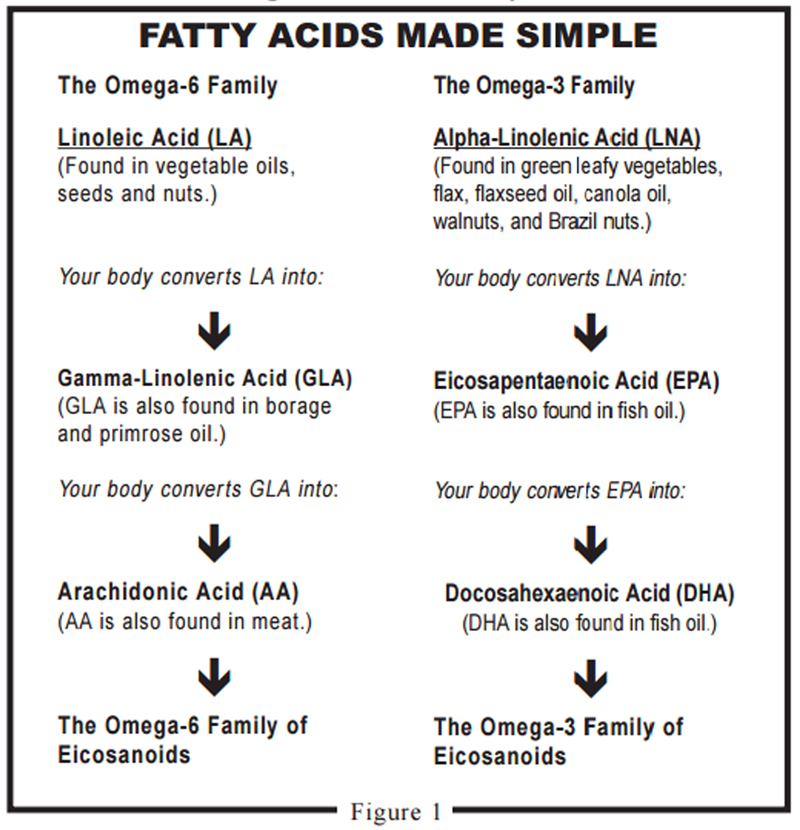
Figure 1 Throughout human history mankind has ingested an approximate equal proportion (1/1 ratio) of Omega-6 to Omega-3 fatty acids. The Omegas 6 and 3 are two of forty-nine known essential nutrients. As essential nutrients they cannot be synthesized by the body, but must be ingested directly in foods or in the form of dietary supplements. The relationship of equivalence between the two Omegas is critical because they self-check each other in a delicate balance to regulate thousands of metabolic functions through prostaglandin pathways. (Figure 1) Nearly every biologic function is somehow interconnected with the delicate balance between Omega-6 and Omega-3.
Omega-3s are intimately involved in the control of inflammation, cardiovascular health, myelin sheath development, allergic reactivity, immune response, hormone modulation, IQ, and behavior. A seemingly minor, yet major change in Omega balance dictated by dietary ingestion has absolute deleterious health effects. The rapid change in dietary fat ingestion within only the last 50–100 years has bewildered human bio-physiology created to function optimally on equal proportions of dietary omegas.
Diets that provide Omega-6 oils at the expense of Omega-3 stimulate pro-inflammatory pathways in the body. While Omega-3's on the other hand stimulates anti-inflammatory pathways. As a result Omega-6 has been coined as "bad" and Omega-3 as "good." In fact both are essential for human health and it is the balance of the two in relation to each other that is important. Dominant Omega-6 in the body can create a situation that promotes chronic inflamation, propagation of cancer, heart disease, stroke, diabetes, arthritis and auto-immunity.
The body's inflammatory response is intimately regulated by Omega-3s. The inflammatory response was created to respond to acute injury or microbial attack. However, if the inflammatory response is needlessly provoked, damage to tissues and organs of the body occurs. The reduction of Omega-3 in the diets of industrialized nations has created a situation of chronic inflamation in these people. In this case, the symptom of inflamation precedes the disease. However, as inflamation leads to disease a vicious circle of inflamation and disease is formed.
Landmark Study Identifies Leading Cause of Degenerative Disease
How important is the balance between Omega-6 and Omega-3?
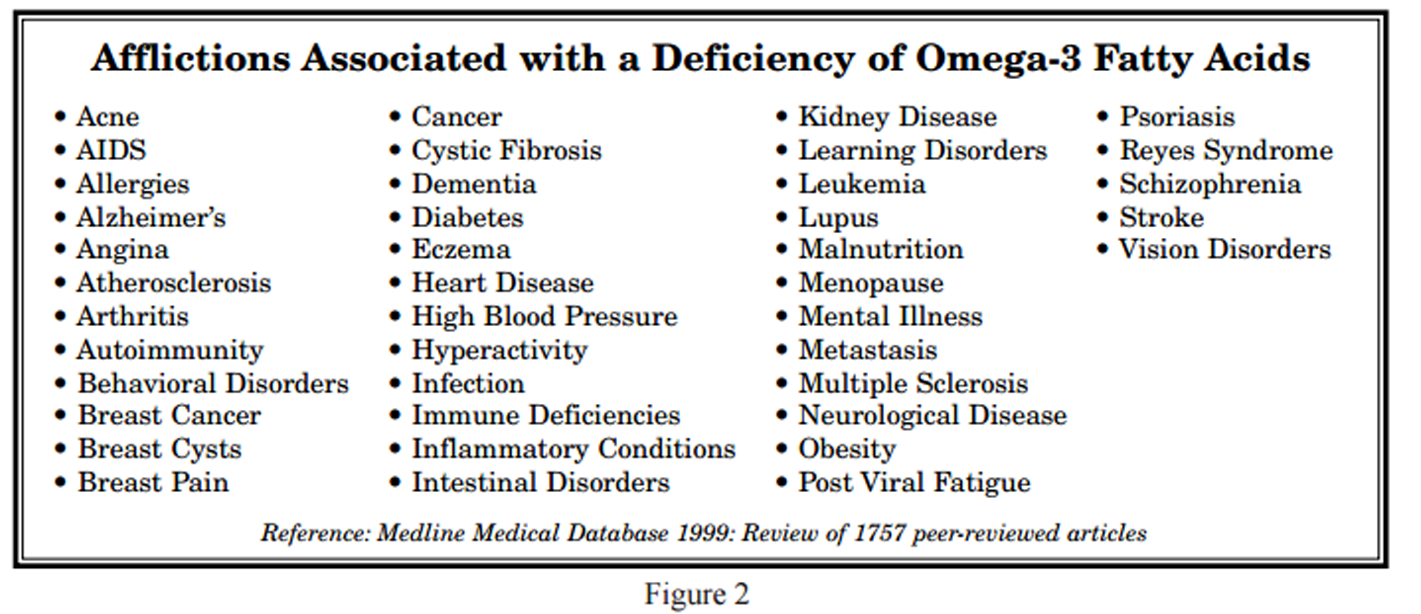
Figure 2
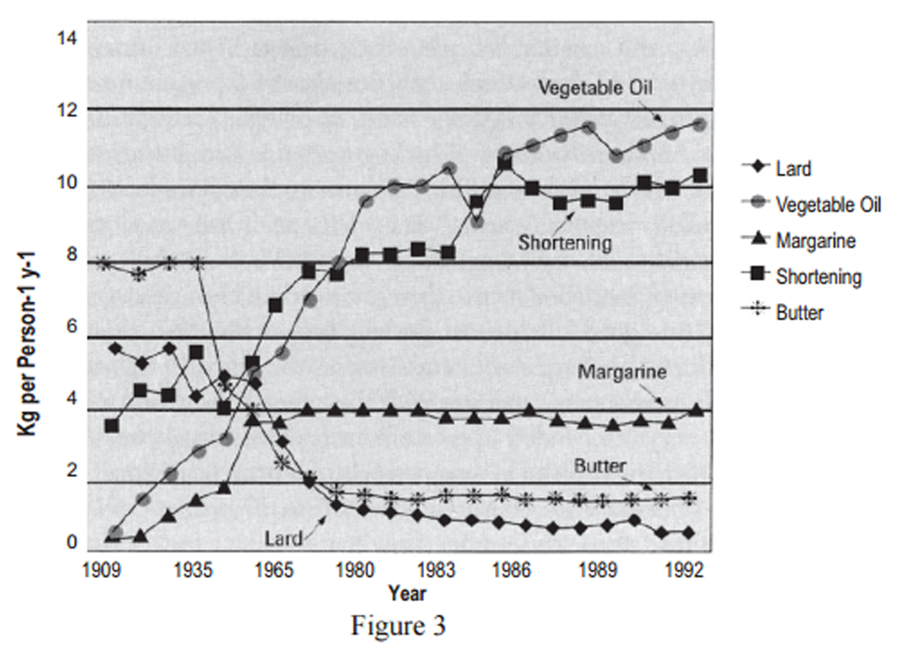
Figure 3 A deficiency of Omega-3 is positively correlated with over 50 diseases and illness including the dreaded diseases of Cancer, Heart Disease, Diabetes, Stroke and Arthritis.
(See Figure 2) The so-called Western degenerative diseases have risen in a near perfect linear fashion with the elimination of Omega-3, and the over-provision of Omega-6 in the food chain. In many regards saturated fats may have been ruled guilty by association as the genesis of cardiovascular disease appears to be more closely related to a rise in vegetable oil ingestion than it does to saturated fat. (Figure 3) Perhaps it should come as no surprise that supplemental ingestion of Omega-3 greatly improves all of the 50 known Omega-3 deficiency conditions.
In a landmark study, Japanese researchers have discovered the leading cause of westernized degenerative diseases in Japan, if not the world. Their work has gone far to confirm the landslide of emerging scientific research which is beginning to reveal that the genesis of degenerative diseases is owed to a drastic reduction in the ingestion of Omega-3 in relation to increased ingestion of Omega-6. Their findings came after an exhaustive review of over 500 peer-reviewed studies and after accounting for all known and suspected causes for degenerative illness. Perhaps most impactful are the words of the Japanese researchers themselves excerpted from the study summary:
"In this review, we summarize the evidence which indicates that increased dietary linoleic acid (Omega-6) and relative Omega-3 deficiency are major risk factors for western-type cancers cardiovascular and cerebrovascular diseases and also for allergic hyper-reactivity. We also raise the possibility that a relative Omega-3 deficiency may be affecting the behavioral patterns of a proportion of the young generations in industrialized countries." It is proposed that dietary intervention with Omega-3 supplementation, and the reduction of Omega-6 in the diet - could successfully reverse rising trend toward westernized degenerative diseases in Japan, and the world. The dietary transition to a westernized diet in Japan occurring in the last 50 years and the subsequent rise in degenerative disease is merely a microcosm of the transition which occurred in the United States beginning with the Industrial Revolution.
Omega-3s — Natures Endangered Nutrient
With the coming of the industrialized revolution roughly 100 years ago came the advent of the screw-nut expeller press for the processing of vegetable/seed oils. Vegetable oils and seeds are dominant in Omega-6 fatty acids, but most are completely devoid of complementary Omega-3 fatty acids. The processing of oils derived from corn, peanut, safflower and sunflower created an extremely concentrated source of Omega-6, at the expense of Omega-3.
Meanwhile, modern methods of animal husbandry were developed to purposely fatten livestock for slaughter. The protocol to date involves pen feeding livestock with carbohydrate rich grains teeming with Omega-6, yet devoid of Omega-3. As a result, the tissues of domestic livestock contain considerably more Omega-6, at the expense of Omega-3, compared to livestock raised as range-free and wild game. Eggs, once a good source of Omega-3, have also fallen victim to progress. Chickens, like cattle, are fed a diet absent of Omega-3, and as a result their eggs are also deficient. Fish, perhaps the most well known source of Omega-3, have also been negatively effected. Chances are the fish on your dining table was "farm" raised and did not eat phytoplankton that creates Omega-3. Refined food manufacturers were quick to learn that Omega-3 significantly decreased the shelf-life and therefore the marketability of their products. Dietary sources of Omega-3 are purposely avoided in the production of processed foods.
Making matters worse was the invention of hydrogenation, a chemical reaction occurring when polyunsaturated vegetable oils are exposed to high heat in the presence of hydrogen and a catalyst such as nickel. Hydrogenation "trans" forms formerly liquid polyunsaturated fats to semi-solid saturated fat-like molecules. Any trace of remaining Omega-3 is hence trans-estrefied into a toxic compound. An astounding study released by Harvard Medical School and published in the American Journal of Clinical Nutrition exposes the ingestion of "trans" fatty acids as the cause for 30,000 premature deaths annually. Hydrogenation affords savvy food manufacturers the shelf stability they desire and the "mouth feel" consumers crave. As a result it is nearly impossible to find a processed food stuff that does not include partially hydrogenated oil as a primary ingredient. Strong consumer backlash of the dangers of trans fatty acids has forced the U.S. government and the FDA to consider listing "trans" fatty acids in the Nutrition Facts Panel under the designation of a saturated fat.

Figure 4 The combination of the above factors has resulted in the near extinction of Omega-3 in the food stream, amid a glut of commercially processed and refined Omega-6. If Omega-3 were an animal, it would be on the endangered list. With the exception of the trace amount of Omega-3 found in greens, sea-vegetables and some nuts and seeds, dietary sources are nil to none. The exception comes in the form of deep water ocean fish and flaxseeds, and flaxseed oil. Unfortunately for people of industrialized nations, dietary habits have shifted from whole-foods consisting of fresh fruit, vegetables, beans, legumes and lean cuts of wild game and free ranging cattle to that of highly refined foodstuffs, domesticated meats and soft-drinks. Consequently, very little Omega-3 is consumed in the average diet.(Figure 4)
A Journey Back to Balance
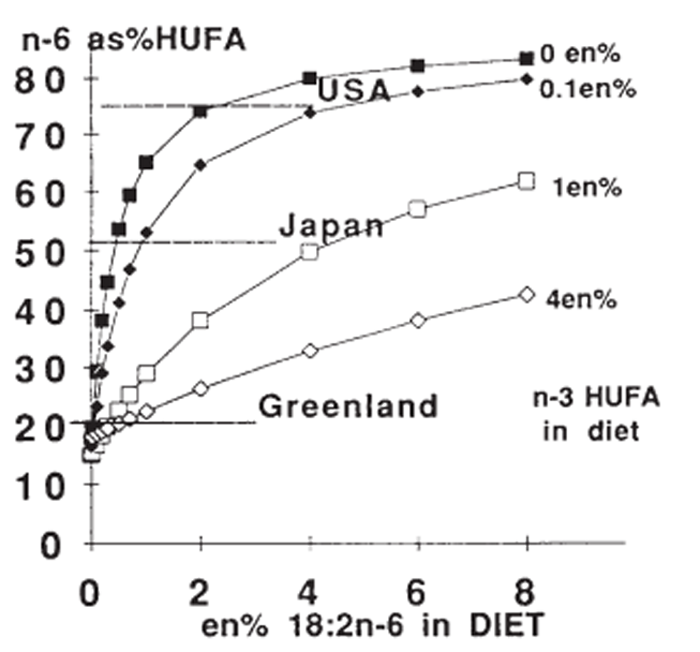
Figure 5 Rapid changes in food processing technology and animal husbandry have created a severe imbalance of Omega-6 to Omega-3 that defies correction through dietary modification alone. However, the good news is that we can work to correct this imbalance in our body by supplementing our diet with Omega-3. Currently the ratio of Omega-6 to Omega-3 in the American Diet ranges from 10/1 to 20/1, and in Japan 4/1 - all grossly in favor of Omega-6. So much so that in North America Omega-6 constitutes 7% of calories consumed or about 15 grams per day. Compare this with only 0 - to 0.3% of calories consumed as Omega-3 per day! Despite these extremely low levels a long-term study in the U.S. showed that people in the upper quintile of Omega-3 ingestion (a mere 0.66 g/ day) had 40% fewer cardiovascular deaths. (Figure 5) Therefore the first practical advice is to consciously limit the amount of Omega-6 in the diet. This can be accomplished by limiting the use of Omega-6 dominant vegetable oils such as safflower, sunflower, peanut and corn oils. Nearly all processed foods contain Omega-6 usually, but not always in the form of "partially" hydrogenated oil. Partial hydrogenation contains both toxic trans-estrified molecules and viable Omega-6, a particularly harmful combination. Despite your best efforts it is simply impossible to eliminate the majority of extraneous Omega-6 your diet.
Omega-3 Supplements
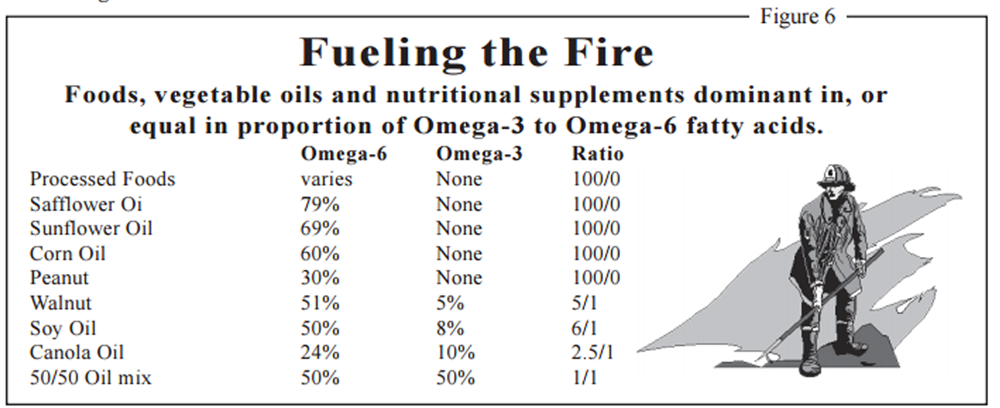
Figure 6 There are currently over 200 products sold under the category of Supplemental Oils in natural foods stores. Every conceivable variation and blend of therapeutic oils exist, many are contradictory and formulated in complete disrespect for the current Omega-6 to 3 crisis. So called "balanced" oils containing a 50/50 ratio of Omega-6 to Omega-3 do nothing more than sustain the status quo in the body - fanning the flames of inflamation and disease. (Figure 6) A 50/50 ratio would seem to make sense since this is the exact ratio that is desired in the body. However supplementing with a 50/50 ratio when the body already has 20 times more Omega-6 does little or nothing to correct imbalance. The only way to begin the journey back to balance is by consumption of oils rich in Omega-3. This process of elimination reduces the field from 200 product variations to two, fish oil and flax oil. Flax oil is the world's most abundant source of Omega-3 containing a whopping 55% by weight. Flax oil provides the true essential Omega-3, alpha-linolenic acid (LNA). LNA is furhter converted by the liver to Eicosapentaenoic acid (EPA) and Docosapentaenoic acid (DHA), long-chain Omega-3 fatty acid molecules. Fish oils are by-products of the fishing industry and a direct source of EPA and DHA. The question is which to take, flax oil or fish oil? Given your unique nutritional needs, either or both may be the answer. Important therapeutic, safety, economic and ecological considerations should be made.
Therapeutic Considerations
The Omegas LNA, EPA, and DHA each offer unique and varied therapeutic and preventative properties. Ideally the body converts the precursor LNA to the derivatives EPA and DHA, thus providing a rate limiting effect tailored to your specific biological needs. However there has been some debate as to whether LNA is efficiently converted to EPA and DHA. A study published in the American Journal of Clinical Nutrition revealed that when the diets of 30 men were supplemented with flax oil, EPA concentrations increased 2.5 fold in plasma fractions and neutrophil phospholipids. Ironically, when the men supplemented with flax oil were compared to men supplemented with fish oil, the flax oil group maintained higher EPA concentrations. A subsequent study revealed that approximately 3 – 6% of LNA is converted to EPA and 1.9 – 3.8% to DHA. This would equate to approximately 231–462 mg. of EPA and 146–292 mg. of DHA per every Tablespoon of flaxseed oil consumed. These levels fall slightly short of the proposed recommended daily intake of combined EPA/DHA of 650 mg. on the low end, and in excess of 650 mg. on the high end as elucidated at a recent symposium held at the National Institutes of Health in Bethesda, Maryland. Taking the recommended dosage of 1–2 tablespoons of flax oil daily fulfills the requirement for LNA, EPA and DHA.
Two Tablespoons of Flax Oil containing 15,400 mg. of Omega-3 goes far to negate the approximate 15,000 mg of Omega-6 consumed on a daily basis. On the other hand, it is rare to find fish oil supplements that exceed 500 mg. of Omega-3. Therefore, flax oil is the only realistic choice for addressing overt Omega-6 to Omega-3 imbalance.
Safety Considerations
Lipid peroxidation occurs when oil containing polyunsaturated fatty acids are exposed to excessive heat, light or oxygen. The more highly unsaturated a fatty acid molecule, the more susceptible to peroxidation. Therefore LNA is more stable than EPA, and EPA more stable than DHA. Fish oils must undergo complex refining to reduce odor, peroxides, free fatty acids and potential toxins due to contaminants such as DDT and methylmercury. Despite these measures standards of quality for fish oils have proven extremely inconsistent. Many companies have been penalized for manufacturing fish oils in excess of toxicity guidelines. Furthermore, several studies have revealed that when fish oils are randomly tested for peroxide values, many of these products exceed the guidelines set by the World Health Organization (W.H.O.) of 10 meq/kg determining rancidity. In comparison, most of the flax oil products on the market are gently expeller pressed without harsh refinement and are derived from organic seeds. The result is a product that is free of chemical contaminants and extremely low in lipid peroxides. For example, one well known American manufacturer of flax oil maintains peroxide levels between 0.1 – 0.5 meq/kg post extraction. Liquid flax oil products are generally found refrigerated offering further protection.
Economic Factors

Figure 7 An estimate of cost for a daily fish oil supplement providing a therapeutic dose can exceed $60.00 per month. Whereas a month's supply of flax oil at a dose of 1 Tablespoon a day will cost less than $14.00. (Figure 7) According to researchers reporting in the American Journal of Clinical Nutrition on the use of flax oil vs. fish oil on tumor regression, "...this stratagem is unsuitable for widespread use because of the high cost of encapsulated fish oil or fish oil concentrates and because of the inconvenience of daily ingestion of moderately large numbers of capsules."
Ecological Considerations
A recent fishing moratorium in China based on dwindling supply sheds light on the fact that the worlds provision of fish may not be a sustainable resource. While fresh (non-farmed) fish are an excellent source of long chain Omega-3's EPA and DHA, fish oil supplements have proven less reliable. Flax oil, manufactured from flaxseeds, is a sustainable resource and is valuable in the rotation and promotion of organic crops.
Summary
A global dietary shift unprecedented in human history favoring the ingestion of Omega-6 at the expense of Omega-3 is being owed as a primary, if not the leading cause of westernized degenerative diseases. In light of this information it is highly advisable to make conscious dietary choices to reduce the amount of extraneous Omega-6 in the diet and to ingest Omega-3 supplements in an effort to return the body to balance. The absolute best choice in accomplishing this goal is Omega-3 rich organic flax oil at a dosage of 1 – 2 Tbsp. per day.
REFERENCES:
- Nettleton JA:
Omega-3 fatty acids: Comparison of plant and seafood sources in human nutrition.
J Am Diet Assoc 91:331-7, 1991
- Cunnane SC, et al.:
Alpha-linolenic acid in humans: Direct functional role or dietary precursor.
Nutrition 7:437-9, 1991
- Mantzioris E, et al.:
Dietary substitution with alpha-linolenic acid-rich vegetable oil increases eicosapentaenoic acid concentrations in tissues.
Am J Clin Nutr 59:1304-9, 1994.
- Simopoulos AP:
Omega-3 fatty acids in health and disease and in growth and development.
Am J Clin Nutr 54:438-63, 1991.
- Bjerve KS, et al.:
Clinical studies with alpha-linolenic acid and long chain n-3 fatty acids.
Nutrition 8:130-2, 1992.
- Belch JF, et al.:
Effects of altering dietary essential fatty acids on requirements for non-steroidal anti-inflammatory drugs in patients with rheumatoid arthritis: a double
- Willett WC, et al.:
Intake of trans fatty acids and risk of coronary heart disease among women.
Lancet 341:581-5, 1993.
- Longnecker MP:
Do trans fatty acids in margarine and other foods increase the risk of coronary heart disease?
Epidemiology 4:492-5, 1993.
- Booyens J and Van Der Merwe CF:
Margarines and coronary artery disease.
Med Hypothesis 37:241-4, 1992.
- Mensink RP and Katan MB:
Effect of dietary trans fatty acids on high-density and low-density lipoprotein cholesterol levels in healthy subjects.
New Engl J Med 323:439-45, 1990.
- Borkman M et al.:
The relationship between insulin sensitivity and the fatty acid composition of skeletal-muscle phospholipids.
N Engl J Med 328:238-44, 1993.
- Bierenbaum ML, et al.:
Reducing atherogenic risk in hyperlipemic humans with flax seed supplementation: A prelimary report.
J Am coll Nutr 12:501-4, 1993.
- Schmidt EB and Dyerberg J:
Omega-3 fatty acids. Current status in cardiovascular medicine.
Drugs 47:405-24, 1994.
- Seidelin KN, Myrup B and Fischer-Hansen B:
n-3 fatty acids in adipose tissue and coronary artery disease are inversely correlated.
Am J Clin Nutr 55:1117-9, 1992
- de Lorgeril M, et al.:
Mediterranean alpha-linolenic acid-rich diet in secondary prevention of coronary heart disease.
Lancet 343:1454-9, 1994.
- Chan JK, Bruce VM and McDonald BE:
Dietary-alpha-linolenic acid is as effective as oleic acid and linoleic acid in lowering blood cholesterol in normonlipidemic men.
Am J Clin Nutr 53:1230-4, 1991
- Belch JF, et al.:
Effects of altering dietary essential fatty acids on requirements for non-steroidal anti-inflammatory drugs in patients with rheumatoid arthritis: a double blind placebo controlled study.
Ann Rheum Dis 47:96-104, 1988.
- Kremer J, et al.:
Effects of manipulation of dietary fatty acids on clinical manifestation of rheumatoid arthritis. Lancet i:184-7, 1985
- Magaro M, et al.: Influence of diet with different lipid composition on neutrophil composition on neutrophil chemiluminescence and disease activity in patients with rheumatoid arthritis.
Ann Rheum Dis 47:793-6, 1988.
- Nielsen GL, et al.:
The effects of dietary supplementation with n-3 polyunsaturated fatty acids in patients with rheumatoid arthritis: a randomized, double-blind trial. Eur J Clin Invest 22:687-91, 1992.
- Mantzioris E, et al.: Dietary substitution with alpha-linolenic acid-rich vegetable oil increases eicosapentaenoic acid concentrations in tissues.
Am J Clin Nutr 59:1304-9, 1994.
- Kelley DS:
Alpha-linolenic acid and immune response. Nutrition 8:215-7, 1992
Simopoulos AP: Omega-3 fatty acids in health and disease and in growth and development.
Am J Clin Nutr 54:438-63, 1991.
- Cunane SC (ed.):
Symposium Proceedings: Third Toronto Essential Fatty Acid Workshop on alpha-Linolenic Acid in Human Nutrition and Disease. May 17-18, 1991, University of Toronto, Toronto, Ontario, Canada. Nutrition 7:435-46, 1991.
- Kelley DS:
Alpha-linolenic acid and immune response.
Nutrition 8:215-7, 1992.
- Sardesai, V.M.,
The Essential Fatty Acids, Nutrition in Clinical Practice, 179-86 Aug. 1992
- Mazen H. et al:
Nutritional Aspects of Flaxseed in the Human Diet: Proceedings of the 54th Annual Flax Proceedings, 48-53, Jan 1992 Stitt P. : Factors in Flaxseed that Help Prevent Cancer: 52nd Annual Flax Institute of the United States, 40-42, 1988.
- Dieken H. :
Use of Flaxseed as a Source of Omega 3 Fatty Acids in Humans: Proceedings of the 54th Annual Flax Proceedings, 1-5, Jan 1992.
- Okuyama, H., et al.
"Dietary fatty acids - the N-6 / N-3 balance and chronic elderly diseases. Excess linoleic acid and relative N-3 deficiency syndrome seen in Japan."
Prog. Lipid Res, 1997; 3(4): 409-457
- Shukla, V :
Rancidity in encapsulated health-food oils: Inform, Vol. 9, no. 10 (October 1998)
vGillian, E et al. "The effect on human tumor necrosis factor alpha and interleukin 1 beta production of diets enriched in n-3 fatty acids from vegetable oil or fish."
Am J Clin Nutr 0, 1996; 63: 116-22
- Lands W.
"Biochemistry and physiology of n-3 fatty acids."
The FASEB Journal, Vol.6 (May 1992)
- Lands W. et al.,
"Maintenance of lower proportion of (n-6) eicosanoid precursors in phospholipids of human plasma in response to added dietary (n-3) fatty acids."
Biochimica et Biophisica Acta, 1180 (1992) 147-162
- Simopoulos A, et al.,
"Workshop on the Essentiality of and Recommended Dietary Intakes for Omega-6 and Omega-3 Fatty Acids." The Center for Genetics, Nutrition and Health., NIH Rockville MD, USA Simopoulos A, et al., "Essential fatty acids in health and chronic disease."
Amer Journal of Clinical Nutrition, Vol 70, No.3 560S-569S (1999)
- Fantoni, C.M. et al.,
"Brazilian encapsulated fish oils: Oxidative stability and fatty acids composition."
JAOCS, Vol. 73, no. 2 (1996)
- Enig M.,
"Trans Fatty Acids - An Update."
Nutrition Quarterly, Vol 17, No. 4 79-104 (1993)
- Ascherio A, et al.,
"Health Effects of trans fatty acids."
Am J Clin Nutr (1997) Oct., 66 (4 Suppl) :1006S-1010S
Return to OMEGA-3 FATTY ACIDS
Return to IMMUNITY AND NUTRITION
Return to NEURODEGENERATIVE DISEASES & EFAs
Since 1-01-2001


| Home Page | Visit Our Sponsors | Become a Sponsor |
Please read our DISCLAIMER |